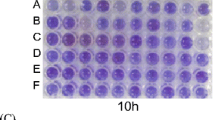Abstract
A novel indigo-producing oxygenase gene, designated ipoA (1,197 bp) was characterized from Rhodococcus sp. strain T104. Three indigo-negative mutations (A58V, P59L, and G251D) were obtained through random mutagenesis using an E. coli mutator strain. Subsequent saturation mutagenesis resulted in the identification of nine and three amino acid substitutions that restore activity in the A58V and P59L mutants, respectively. Activity was not restored in the G251D mutation by any other amino acids. Interestingly, activity in the A58V mutant, where a methyl group is only replaced by an isopropyl side chain, is restored by a variety of amino acids, including polar ones. A molecular modeling study suggests that the residues at positions 58, 59, and 251 of the T104 IpoA enzyme are far from the active site, indicating that the mutations must alter the overall structure of the enzyme.



Similar content being viewed by others
References
Alfieri A, Fersini F, Ruangchan N, Prongjit M, Chaiyen P, Mattevi A (2007) Structure of the monooxygenase component of a two-component flavoprotein monooxygenase. Proc Natl Acad. Sci USA 104:1177–1182
Brazeau BJ, Lipscomb JD (2003) Key amino acid residues in the regulation of soluble methane monooxygenase catalysis by component B. Biochemistry 42:5618–5631
Choi HS, Kim JK, Cho EH, Kim YC, Kim JI, Kim SW (2003) A novel flavin-containing monooxygenase from Methylophaga sp. strain SK1 and its indigo synthesis in Escherichia coli. Biochem Biophys Res Commun 306:930–936
Choi KY, Kim D, Koh S-C, So J-S, Kim J-S, Kim E (2004) Molecular cloning and identification of a novel oxygenase gene specifically induced during the growth of Rhodococcus sp. strain T104 on limonene. J Microbiol 42:160–162
Doukyu N, Toyoda K, Aono R (2003) Indigo production by Escherichia coli carrying the phenol hydroxylase gene from Acinetobacter sp. strain ST-550 in a water-organic solvent two-phase system. Appl Microbiol Biotechnol 60:720–725
Eaton RW, Chapman PJ (1995) Formation of indigo and related compounds from indolecarboxylic acids by aromatic acid-degrading bacteria: chromogenic reactions for cloning genes encoding dioxygenases that act on aromatic acids. J Bacteriol 177:6983–6988
Ensley BD, Ratzkin BJ, Osslund TD, Simon MJ, Wackett LP, Gibson DT (1983) Expression of naphthalene oxidation genes in Escherichia coli results in the biosynthesis of indigo. Science 222:167–169
Furuya T, Takahashi S, Ishii Y, Kino K, Kirimura K (2004) Cloning of a gene encoding flavin reductase coupling with dibenzothiophene monooxygenase through coexpression screening using indigo production as selective indication. Biochem Biophys Res Commun 313:570–575
Guengerich FP, Martin F, McCormick MV, Nguyen WA, Glover LP, Bradfield E (2004) Aryl hydrocarbon receptor response to indigoids in vitro and in vivo. Arch Biochem Biophys 423:309–316
Hernandez BS, Koh S-C, Chial M, Focht DD (1997) Terpene-utilizing isolates and their relevance to enhanced biotransformation of polychlorinated biphenyls in soil. Biodegradation 8:153–158
Hoessel R, Leclerc S, Endicott JA, Nobel ME, Lawrie A, Tunnah P, Leost M, Damiens E, Marie D, Marko D, Niederberger E, Tang W, Eisenbrand G, Meijer L (1999) Indirubin, the active constituent of a Chinese antileukaemia medicine, inhibits cyclin-dependent kinases. Nat Cell Biol 1:60–67
Keil H, Saint CM, Williams PA (1987) Gene organization of the first catabolic operon of TOL plasmid pWW53: production of indigo by the xylA gene product. J Bacteriol 169:764–770
Leclerc S, Garnier M, Hoessel R, Marko D, Bibb JA, Snyder GL, Greengard P, Biernat J, Wu YZ, Mandelkow EM, Eisenbrand G, Meijer L (2001) Indirubins inhibit glycogen synthase kinase-3 beta and CDK5/p25, two protein kinases involved in abnormal tau phosphorylation in Alzheimer’s disease.A property common to most cyclin-dependent kinase inhibitors? J Biol Chem 276:251–260
Lim HK, Chung EJ, Kim J-C, Choi GJ, Jang KS, Chung YR, Cho KY, Lee S-W (2005) Characterization of a forest soil metagenome clone that confers indirubin and indigo production on Escherichia coli. Appl Environ Microbiol 71:7768–7777
McClay K, Boss C, Keresztes I, Steffan RJ (2005) Mutations of toluene-4-monooxygenase that alter regiospecificity of indole oxidation and lead to production of novel indigoid pigments. Appl Environ Microbiol 71:5476–5483
O'Connor KE, Dobson AD, Hartmans S (1997) Indigo formation by microorganisms expressing styrene monooxygenase activity. Appl Environ Microbiol 63:4287–4291
Rui L, Reardon KF, Wood TK (2005) Protein engineering of toluene ortho-monooxygenase of Burkholderia cepacia G4 for regiospecific hydroxylation of indole to form various indigoid compounds. Appl Microbiol Biotechnol 66:422–429
Sakamoto T, Joern JM, Arisawa A, Arnold FH (2001) Laboratory evolution of toluene dioxygenase to accept 4-picoline as a substrate. Appl Environ Microbiol 67:3882–3887
Schwede T, Kopp J, Guex N, Peitsch MC (2003) SWISS-MODEL: an automated protein homology-modeling server. Nucleic Acids Res 31:3381–3385
Wallar BJ, Lipscomb JD (2001) Methane monooxygenase component B mutants alter the kinetics of steps throughout the catalytic cycle. Biochemistry 40:2220–2233
Zhang J, Lipscomb JD (2006) Role of the C-terminal region of the B component of Methylosinus trichosporium OB3b methane monooxygenase in the regulation of oxygen activation. Biochemistry 45:1459–1469
Zylstra GJ, McCombie WR, Gibson DT, Finette BA (1988) Toluene degradation by Pseudomonas putida F1: genetic organization of the tod operon. Appl Environ Microbiol 54:1498–1503
Acknowledgment
This work was supported by a grant from the Ministry of Science and Technology, Republic of Korea through the 21C Frontier Microbial Genomics and also in part by the Basic Research Program of the Korea Science and Engineering Foundation (Grant No. R01-2006-000-10136-0). NRK and KYC are recipients of Brain Korea 21 scholarships. GJZ acknowledges the support of NSF through grants MCB-0078465 and CHE-0221978.
Author information
Authors and Affiliations
Corresponding authors
Additional information
Na Ra Kwon and Jong-Chan Chae equally contributed to this work
Rights and permissions
About this article
Cite this article
Kwon, N.R., Chae, JC., Choi, K.Y. et al. Identification of functionally important amino acids in a novel indigo-producing oxygenase from Rhodococcus sp. strain T104. Appl Microbiol Biotechnol 79, 417–422 (2008). https://doi.org/10.1007/s00253-008-1445-y
Received:
Revised:
Accepted:
Published:
Issue Date:
DOI: https://doi.org/10.1007/s00253-008-1445-y




